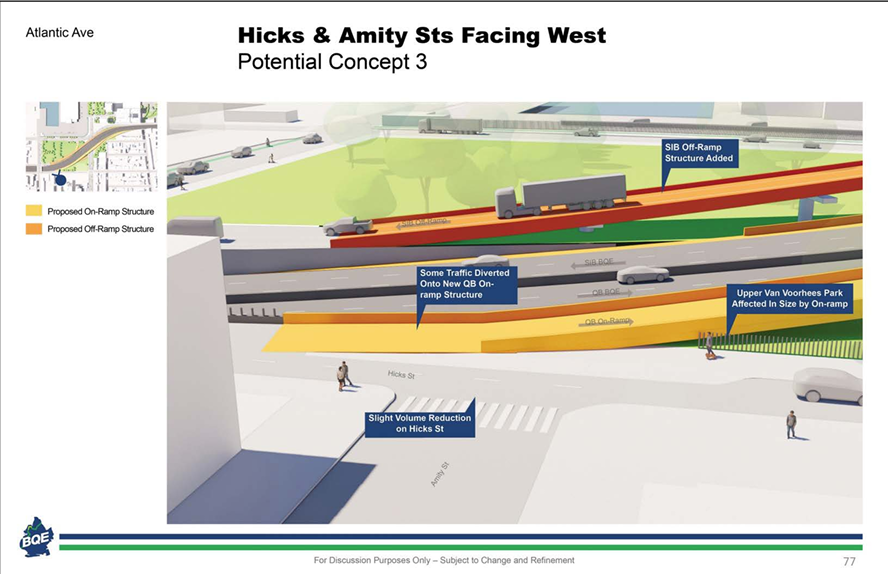
On June 15, 2023, the New York City Department of Transportation (“DOT”) held a community engagement meeting to propose solutions for “Zone 5” of the Brooklyn-Queens Expressway (“BQE”), which includes the Atlantic Avenue interchanges and the parcels of Van Voorhees Park (upper and lower) trisected by the BQE and on/off ramps (among the most dangerous in the country).
At this meeting, DOT presented three “concepts”. The first concept moved the Staten-Island bound off-ramp from Columbia Street to the intersection of Furman Street and Atlantic Avenue, adding another lane of traffic to the already dangerous intersection. DOT conceded this concept did little to reduce traffic while increasing danger to pedestrians. DOT then presented two concepts that proposed placing a Queens bound BQE on-ramp on Hicks Street at Congress Street – essentially making Hicks Street an extension of the highway.
Please read the Cobble Hill Association’s full statement on why this proposal would increase traffic congestion exacerbate the risks to the health and safety of the pedestrians in Cobble Hill and our surrounding communities.
Where do we go from here?
First, we want more public engagement. Three of our elected officials (State Senator Andrew Gounardes, Assemblymember JoAnne Simon, Councilmember Shahana Hanif) wrote to DOT Commissioner Rodriguez calling for additional public sessions and will be working with DOT to schedule these events.
Additionally, we are calling on DOT to incorporate the community feedback into a broader vision for the BQE, while taking significant measures NOW to reduce congestion and improve pedestrian safety.
Immediate ways to reduce traffic and protect pedestrians:
- Stop the traffic on our residential streets. Do not allow drivers to bypass the trench and use Hicks, Columbia and Clinton streets as alternate highway lanes. Human health and safety are at stake! This is NYC jurisdiction and DOT can make it happen. Examples of actions DOT can take include:
- Making Hicks and Columbia Streets local traffic only. Employ smart street technology to ticket through traffic reentering the BQE.
- Keep trucks off of Hicks and Columbia Streets – if they are destined for northbound landing they must stay on the BQE and continue through the trench. They can take the Atlantic Avenue exit if that is their destination.
- Enforce WIM (weigh in motion) and allow no overweight trucks on the roadway and ensure they do not use our surface streets.
- Enforce and stop the long tractor trailers of over 52’ from entering our city and our roadways. This is the law.
- Expand sidewalks and reduce pedestrian crossings as proposed throughout all three Concepts (i.e., shorter, more compact crossing distances that limit slip lanes and turn lanes and improve the pedestrian crossing experience”). There is no need to wait for a complete redesign to put these safety measures in place.
Objectives for the broader vision of the City-controlled portions of the BQE, including Zone 5:
- NO ON-RAMP ON HICKS STREET. This proposal must be taken off the table entirely.
- Study the feasibility of removing the Queens bound on-ramp at Atlantic Avenue.
- Explore more innovative solutions to reconnect Upper and Lower Van Voorhees Park. If DOT is willing to expand Congress Street to accommodate cars, it should be able to do the same for pedestrians. Similarly, if DOT can build an on-ramp over Upper Van Voorhees, there should be a way to build a bridge or crossing re-connecting Upper and Lower Van Voorhees.
- Apply for federal and state money to do a corridor-wide feasibility and planning study with the objectives to reduce private car trips on the BQE and its alternate routes through residential communities.
- Remove trucks from our streets and advance new modes of freight movement – including inbound rail and water and outbound bicycle and last mile strategies.
- Prioritize the health and safety of humans by reducing exposure to highways, traffic and dangerous road conditions. Move parks, green space and other public facilities away from highways and high volume streets and eliminate exposure to pollution from vehicles.